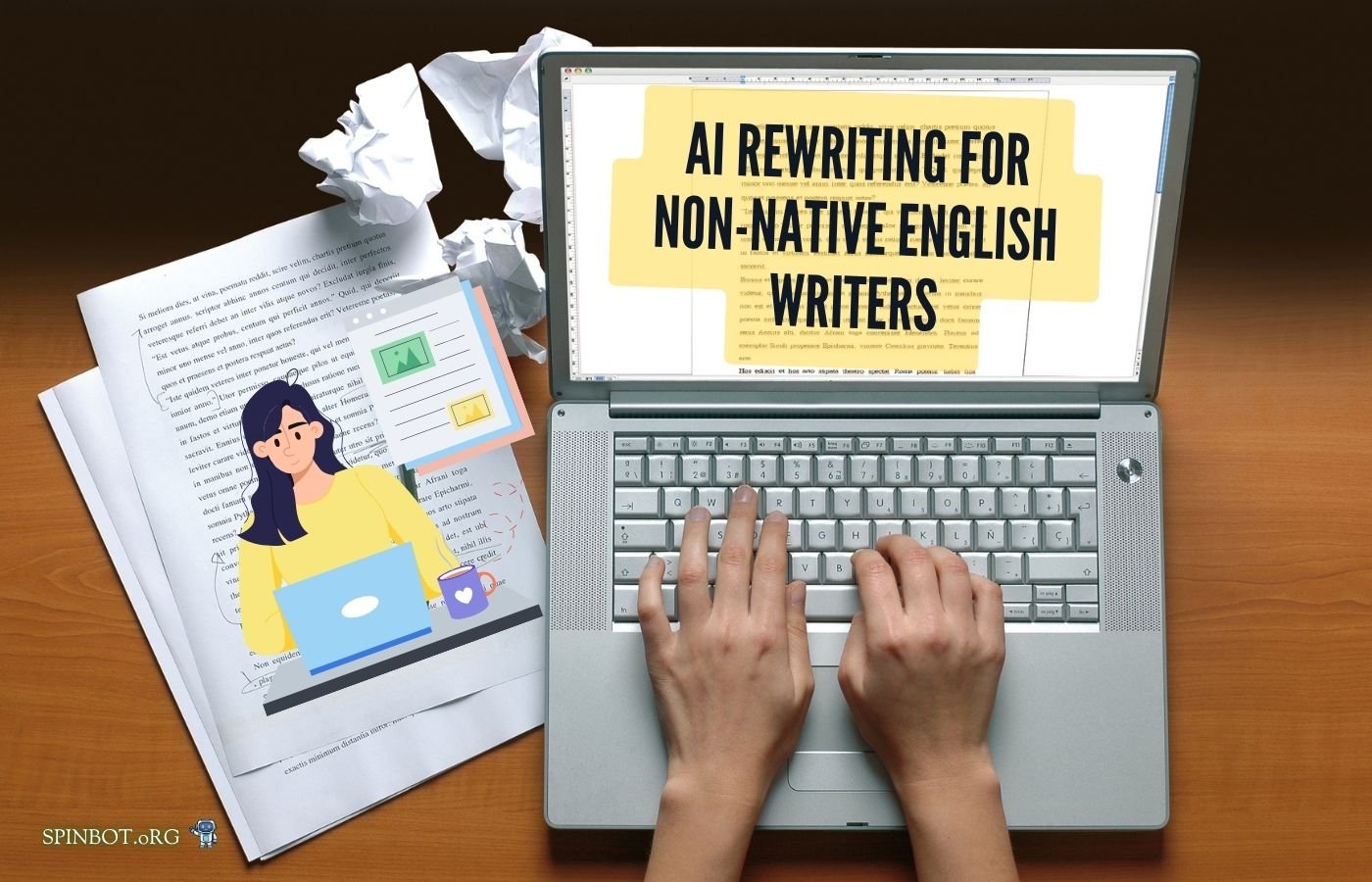In this article, we’ll explore how AI rewriting tools can help non-native English writers overcome language barriers, improve their writing, and achieve greater success in both personal and professional writing.
Understanding AI Rewriting: What Is It?
AI rewriting refers to the use of artificial intelligence algorithms to assist writers in rephrasing, improving, or enhancing their written content. These tools work by analyzing text, recognizing language patterns, and generating alternative versions that are more fluent or stylistically improved.
Key Features of AI Rewriting Tools
Paraphrasing: AI can rewrite sentences to make them more readable or varied while preserving the original meaning.
Grammar and Spelling Checks: AI tools often come with integrated grammar checkers to correct errors.
Style Enhancement: AI can suggest changes in tone, formality, and clarity to align with the intended audience.
AI rewriting works by using Natural Language Processing (NLP), a branch of AI focused on how computers can understand and manipulate human language. Over time, AI tools have become more sophisticated, improving their ability to produce content that is human-like and contextually appropriate.
The Challenges Faced by Non-Native English Writers
While many non-native English writers can grasp the basics of the language, they still face specific challenges in writing:
1. Vocabulary and Grammar Limitations
Non-native speakers often struggle with appropriate word choice, idiomatic expressions, and grammatical errors. These can lead to awkward sentences and miscommunication.
2. Sentence Structure and Flow
Sentence structure varies significantly between languages. Non-native speakers may have difficulty forming sentences that flow naturally in English.
3. Cultural Nuances
Understanding the subtle cultural nuances in English writing, such as tone and formality, is a common challenge for non-native writers. Misunderstanding these can affect the tone of the writing, making it seem out of place or inappropriate.
4. Writing Style
Non-native writers may not always know how to write in a style that suits their audience, whether that’s professional, academic, or creative. AI rewriting tools can guide users in making their writing more appropriate and polished.
AI rewriting tools can help overcome these challenges by offering suggestions and corrections that improve clarity, fluency, and readability.
How AI Rewriting Tools Help Non-Native English Writers
AI rewriting tools offer several key benefits for non-native English writers. Here’s how these tools help:
1. Correcting Grammar and Syntax
AI grammar checkers automatically detect errors in sentence structure, verb tenses, prepositions, and word usage. These tools suggest corrections to improve the clarity and readability of the text.
AI can identify mistakes that are common for non-native writers, like incorrect word order, subject-verb agreement, and articles (e.g., “the” vs. “a”).
2. Enhancing Vocabulary and Word Choice
Non-native English speakers may struggle with word choice. AI rewriting tools can suggest more appropriate or natural-sounding synonyms, helping users express their ideas more fluently.
For example, if you write “happy,” an AI tool might suggest using “elated” or “content,” depending on the context.
3. Improving Sentence Structure
AI tools help with sentence flow by rearranging words or phrases to improve readability. They can turn awkwardly structured sentences into smooth, easy-to-understand expressions.
4. Adapting Tone and Style
AI tools can adjust the tone of the writing to suit the intended audience. Whether the goal is to make the text more formal, professional, casual, or conversational, AI rewriting tools make these adjustments seamlessly.
By analyzing the tone of the original content, the AI provides suggestions that make the writing sound more natural for a native speaker.
5. Making Writing More Concise
Non-native writers often use unnecessary words, which can make their sentences convoluted. AI can help condense and simplify sentences without losing their meaning.
Popular AI Rewriting Tools for Non-Native Writers
1. Grammarly
Grammarly is one of the most popular AI writing tools, offering grammar and spelling checks, as well as style enhancements. It provides detailed suggestions for improving sentence structure and word choice. Although the free version is quite useful, Grammarly Premium offers advanced suggestions for tone adjustments and plagiarism detection.
2. QuillBot
QuillBot is an AI tool specifically designed for paraphrasing and rewriting. It allows users to rewrite sentences, paragraphs, and even entire articles while maintaining the original meaning. It also offers a thesaurus feature to help expand vocabulary.
3. Spinbot
Spinbot is a free AI tool that automatically rewrites text. While it doesn’t provide as advanced grammar checks or stylistic suggestions, it is a great option for non-native writers who need quick rewrites to improve fluency.
4. Paraphrase Online
Paraphrase Online is a simple tool that helps non-native writers rephrase text to make it more readable and clear. It’s easy to use and works well for those needing to improve their sentence structure.
5. ProWritingAid
ProWritingAid offers a comprehensive suite of writing tools that check for grammar, style, readability, and structure. It helps non-native writers improve their writing by focusing on both the technical and creative aspects of writing.
How to Choose the Right AI Rewriting Tool for Non-Native English Writers
When selecting an AI rewriting tool, consider these factors:
Ease of Use: Choose a tool with an intuitive interface that is easy to navigate.
Features: Look for tools with features such as grammar checking, sentence structure suggestions, and tone adjustments.
Cost: Some tools, like Grammarly and QuillBot, offer free versions with limited features. Determine whether the paid version is worth the investment for your needs.
Accuracy: Test the tool to see how accurately it rewrites content without changing the meaning.
Practical Tips for Non-Native English Writers Using AI Rewriting Tools
1. Combine AI with Manual Editing
While AI tools are powerful, they are not perfect. Always review AI-suggested changes to ensure they align with your intentions. Combining AI with your own editing will ensure the final content meets your needs.
2. Use AI as a Learning Tool
AI rewriting tools can be used to understand why certain phrases or words are more effective in English. Pay attention to the suggestions provided by the tool and try to implement them in your own writing over time.
3. Set Specific Goals for AI Use
Decide what aspect of your writing you want to improve—whether it’s grammar, sentence structure, or vocabulary. Focus on using AI tools to enhance that specific aspect until it becomes natural for you.
4. Experiment with Different Tools
Try out different AI rewriting tools to find the one that suits your needs best. Each tool has its unique features, so experimenting with several will help you find what works for you.
5. Understand Your Writing Style
While AI tools can suggest style changes, it’s important to understand your own writing style. Use AI to guide you, but always make sure the final product reflects your voice and intent.
Common Mistakes to Avoid When Using AI Rewriting Tools
1. Over-Reliance on AI Suggestions
AI tools are helpful, but they should not replace your own critical thinking. Avoid relying too heavily on them without reviewing the changes.
2. Ignoring Context
AI rewriting tools can sometimes change the meaning of a sentence. Always double-check that the context of your writing remains intact after edits.
3. Neglecting Originality
Plagiarism is a concern when using AI tools, especially when the tool rewrites content from other sources. Make sure to rewrite AI-generated content in a way that’s truly original and reflects your own style.
4. Forgetting to Review for Tone and Clarity
Sometimes, AI suggestions can alter the tone of your writing. Ensure that the tone is appropriate for your intended audience and that your content remains clear.
Free AI Rewriting Tools: Are They Effective?
For those who want to improve their writing on a budget, free AI rewriting tools can be a great option. Some of the best free AI rewriters include:
Spinbot: A free tool that automatically rewrites text, making it more readable.
Paraphrase Online: A simple tool that helps rephrase text for clarity and flow.
QuillBot (Free Version): Offers limited paraphrasing and sentence restructuring features for free.
While these free tools are beneficial, they often lack the advanced features available in paid versions. However, they can still be effective for basic rewriting tasks.
The Future of AI Rewriting Tools
As AI technology advances, we can expect even more sophisticated rewriting tools that offer more nuanced language improvements. AI tools will continue to assist non-native English writers by offering greater accuracy, more personalized writing suggestions, and enhanced learning features. However, as AI becomes more advanced, there will also be ethical concerns, such as potential biases in AI algorithms. It’s important to be aware of these issues and continue to rely on human judgment in the writing process.
Conclusion: AI Rewriting Is a Valuable Tool for Non-Native English Writers
AI rewriting tools have proven to be a valuable resource for non-native English writers, helping them improve their writing skills and produce more polished, professional content. By using AI tools effectively and combining them with manual editing, writers can overcome language barriers and develop their writing to a higher standard. Whether you’re a student, professional, or creative writer, AI rewriting tools can be a game-changer, making the writing process smoother and more efficient.
Explore different AI tools, use them as learning aids, and continue to refine your skills. With the help of AI, non-native writers can become more confident and capable in their English writing endeavors.

Academic editor turned AI copy pro, Sarah-Jane fuses research precision with smart storytelling. Her insights build trust, spark ideas, and elevate every word with real-world writing experience.

